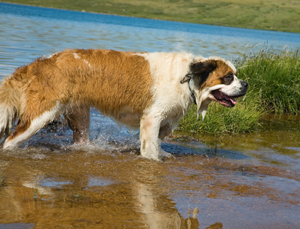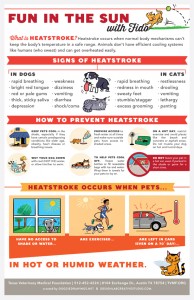Heatstroke: Heat Can be Fatal to Your Pet

What is heatstroke?
Heatstroke is a medical emergency for a dog and requires veterinary treatment. Heatstroke occurs when a dog’s normal body mechanisms cannot keep the body’s temperature in a safe range. The average normal body temperature for a dog is 101.5 F. A dog with heatstroke will often have a temperature in the range of 104 F to 106 F. Severe heatstroke can result in gastrointestinalOf or relating to the stomach and the intestines. upset, dysfunction of internal organs, spontaneous internal bleeding, widespread infection and death.
What can cause heatstroke?
Unlike people, dogs have limited means of dispelling excess heat. Dogs are only able to sweat via their footpads, and their main method of cooling down is panting, which can be inhibited by several factors. For example, on a very humid day in Texas, a dog will have a harder time expelling excess heat through panting. Also, dogs with short faces and noses (known as brachycephalic breeds) will physically have more difficulty cooling off via panting, making these breeds more prone to heatstroke. Common brachycephalic breeds include bulldogs, pugs, shih tzu, Boston terriers and boxers. Although every breed of dog can suffer from this emergency, extreme caution should be used with brachycephalic breeds and dogs with “smushed faces” during the hotter months in Texas.
Dogs may get heatstroke after outside exercise on a warm day. Indoor dogs that venture outside to exercise tend to get it more commonly, although it can occur in dogs that live outdoors as well. Heatstroke also occurs when pets are left in hot cars or forgotten outside on a hot Texas day, especially when they have limited or no access to drinking water. Pets also can suffer from it when swimming for long periods.
What are the common symptoms of heatstroke?
A dog that is beginning to overheat will often act distressed and restless while panting excessively. Its tongue may protrude far out of its mouth and appear swollen and red. As the dog’s body temperature continues to increase, it may drool large amounts of saliva from the nose and/or mouth and may start to have vomiting and/or diarrhea. The dog may become unsteady on its feet or collapse and become poorly responsive. Its gums also may turn blue, purple or bright red in color, which is due to inadequate oxygen.
If you suspect your pet is overheating…
 If you suspect your dog may be overheating, immediately move it indoors or into the shade if you are unable to bring it inside. Place a fan on your dog, and you may wet its earflaps and paws with cool water. Never immerse your pet fully in water or an ice bath. This will cause its temperature to rapidly drop to potentially too low of a temperature. Complications from a low body temperature immediately following heatstroke can be just as serious as heatstroke alone. Offer your pet water, but do not force your pet to drink. Once these steps have been taken, it can be helpful to know the pet’s temperature, if it can be taken safely. Transport your pet to the nearest veterinary facility immediately. Even if your pet seems to be recovering, the effects of heatstroke often are not immediate and are subtle, although serious.
If you suspect your dog may be overheating, immediately move it indoors or into the shade if you are unable to bring it inside. Place a fan on your dog, and you may wet its earflaps and paws with cool water. Never immerse your pet fully in water or an ice bath. This will cause its temperature to rapidly drop to potentially too low of a temperature. Complications from a low body temperature immediately following heatstroke can be just as serious as heatstroke alone. Offer your pet water, but do not force your pet to drink. Once these steps have been taken, it can be helpful to know the pet’s temperature, if it can be taken safely. Transport your pet to the nearest veterinary facility immediately. Even if your pet seems to be recovering, the effects of heatstroke often are not immediate and are subtle, although serious.
How does a veterinarian typically treat heatstroke?
When you arrive at the veterinary clinic, staff will take over safely cooling your pet. If your veterinarian is concerned your pet has suffered heatstroke, your pet will likely be hospitalized for intravenous (IV) fluids, anti-nausea medications and antibiotics. Your veterinarian will be monitoring bloodwork frequently for signs of internal complications. As complications are not always immediate, close care and monitoring is essential for recovery. The values your veterinarian will be watching particularly closely are blood clotting times, blood sugar, kidney function, red and white blood cell counts, plateletA small colorless disk-shaped cell fragment without a nucleus, found in large numbers in blood and involved in clotting. counts and blood protein counts. Often these more critical lab tests are evaluated several times a day. Many dogs with moderate to severe heatstroke will need plasma transfusions to support their internal clotting function. PancreatitisInflammation of the pancreas., although treatable, is another common effect of this emergency.
While prompt veterinary treatment is the pet owner’s safest and most effective option, it should be noted that, in some cases, critical care for heatstroke patients can be quite costly.
What could happen if heatstroke goes untreated?
Left untreated, heatstroke can be fatal, and, in some cases, even with aggressive treatment, irreversible kidney failure can occur. Most pets will remain in the hospital for one to five days, and while some dogs with less severe cases are successfully treated at their family veterinary clinics, mores severe cases or pets requiring transfusions may need to be hospitalized in an intensive care unit (ICU) or 24-hour facility.
How can heatstroke be avoided?
A good rule of thumb is that once the outside temperature is above 80 F with a humidity of at least 90 percent, pets are at risk for heatstroke. When this occurs, keep in mind that the following should be avoided:
- Running or jogging with your dog
- Having your dog ride in the bed of a pickup truck
- Keeping your dog staked out in the yard
- Leaving your dog in the car for any amount of time
- Playing fetch with your dog outdoors
- Letting your dog play hard with other dogs in the park
- Leaving your dog at a daycare at which it is left outdoors. Ask your dog daycare what their outdoor-time procedures are.
If your dog lives primarily indoors, walks outside and other outside exercise should occur only in the cooler mornings or evenings during warmer weather. Even if your dog is used to exercising, a longer than normal walk or jog on a hotter than typical day can result in heatstroke. Also, make sure your dog always has access to water and encourage it to take breaks from exercising in the shade.
Heatstroke is a very serious, preventable disease in Texas. Use caution with your dog when outdoors in the warmer months, and remember that many dogs will walk that extra mile or chase the ball again, despite the damage occurring in their bodies. If you suspect your pet has suffered heatstroke, do not delay veterinary care!
Dr. Christine New practices veterinary medicine at the Hillside Veterinary Clinic in Dallas.



[…] Pet Heat Stroke Prevention […]
[…] veterinarian-written and reviewed pet health information. For more information on heatstroke, visit http://www.texvetpets.org/article/heatstroke-heat-can-be-fatal-to-your-pet. To download a colorful and informational poster about how to spot and prevent heatstroke, visit […]
[…] more information on heatstroke, visit http://www.texvetpets.org/article/heatstroke-heat-can-be-fatal-to-your-pet. To download a colorful and informational poster about how to spot and prevent heatstroke, visit […]
[…] more information on heatstroke, visit http://www.texvetpets.org/article/heatstroke-heat-can-be-fatal-to-your-pet. To download a colorful and informational poster about how to spot and prevent heatstroke, visit […]
[…] Be watchful of heatstroke. Dogs can get heatstroke just like humans. (So can cats.) Signs include rapid breathing, a bright red tongue, red or pale gums, thickened saliva, depression, refusal to walk, diarrhea, and stumbling or staggering. [For more information on heatstroke, visit www.texvetpets.org/article/heatstroke-heat-can-be-fatal-to-your-pet.] […]
[…] Pet Heat Stroke Prevention […]
[…] more information on heatstroke, visit http://www.texvetpets.org/article/heatstroke-heat-can-be-fatal-to-your-pet. To download a colorful and informational poster about how to spot and prevent heatstroke, visit […]